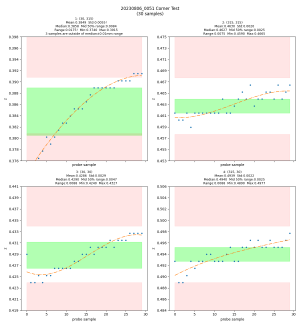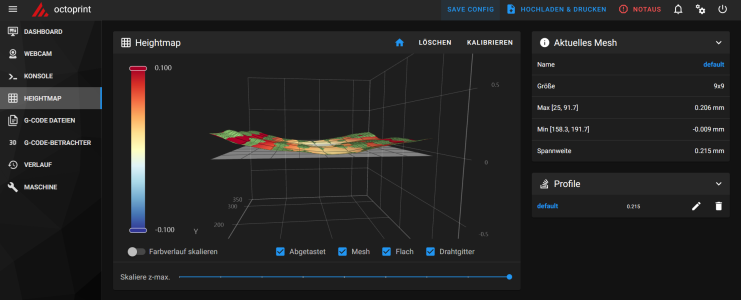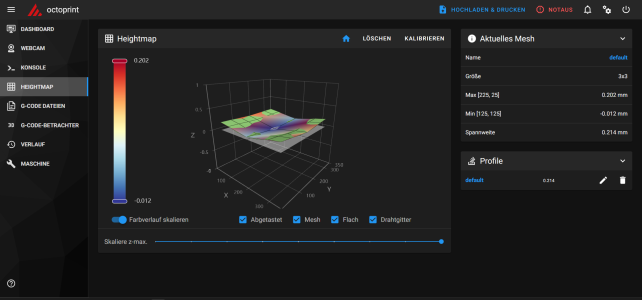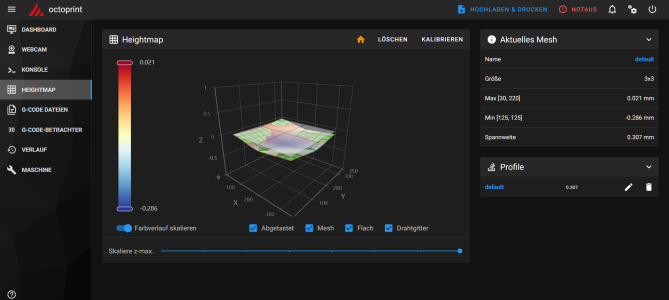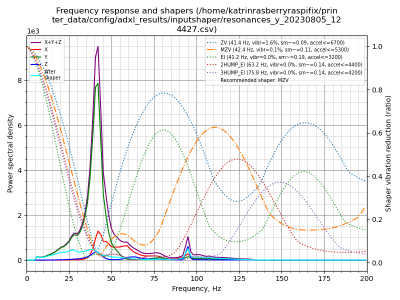I just read in another thread that there is a tool on Github probe_accuracy_testprobe_accuracy_test
If I understand the graphic correctly, the Z belts are not the same
Leveling
4...3...2...1...Done
min max first last mean std count range drift
test
1:corner 30samples (30, 315) 0.405665 0.415665 0.415665 0.408165 0.408373 0.001740 30 0.01000 -0.00750
2:corner 30samples (315, 315) 0.503165 0.506915 0.506915 0.503165 0.504457 0.001333 30 0.00375 -0.00375
3:corner 30samples (30, 30) 0.434415 0.440665 0.440665 0.436915 0.435873 0.001471 30 0.00625 -0.00375
4:corner 30samples (315, 30) 0.513165 0.518165 0.516915 0.516915 0.515748 0.001269 30 0.00500 0.00000
--------------------------------------------------------------------------------
Take 20 probe_accuracy tests to check for repeatability
Test number: 20...19...18...17...16...15...14...13...12...11...10...9...8...7...6...5...4...3...2...1...Done
min max first last mean std count range drift
test
01: center 10samples 0.730665 0.735665 0.735665 0.731915 0.731915 0.001443 10 0.00500 -0.00375
02: center 10samples 0.730665 0.738165 0.738165 0.730665 0.731540 0.002361 10 0.00750 -0.00750
03: center 10samples 0.728165 0.735665 0.735665 0.729415 0.729915 0.002220 10 0.00750 -0.00625
04: center 10samples 0.728165 0.734415 0.734415 0.728165 0.729665 0.001936 10 0.00625 -0.00625
05: center 10samples 0.724415 0.730665 0.730665 0.724415 0.725165 0.001972 10 0.00625 -0.00625
06: center 10samples 0.729415 0.734415 0.734415 0.730665 0.730665 0.001443 10 0.00500 -0.00375
07: center 10samples 0.725665 0.733165 0.733165 0.728165 0.727665 0.002058 10 0.00750 -0.00500
08: center 10samples 0.719415 0.726915 0.726915 0.721915 0.721915 0.001954 10 0.00750 -0.00500
09: center 10samples 0.724415 0.730665 0.730665 0.725665 0.725665 0.001863 10 0.00625 -0.00500
10: center 10samples 0.721915 0.728165 0.728165 0.721915 0.722915 0.002024 10 0.00625 -0.00625
11: center 10samples 0.723165 0.731915 0.731915 0.723165 0.724915 0.002582 10 0.00875 -0.00875
12: center 10samples 0.724415 0.730665 0.730665 0.725665 0.725790 0.001811 10 0.00625 -0.00500
13: center 10samples 0.723165 0.731915 0.731915 0.725665 0.725540 0.002462 10 0.00875 -0.00625
14: center 10samples 0.724415 0.730665 0.730665 0.724415 0.726040 0.001773 10 0.00625 -0.00625
15: center 10samples 0.719415 0.725665 0.725665 0.720665 0.720915 0.001748 10 0.00625 -0.00500
16: center 10samples 0.715665 0.723165 0.723165 0.718165 0.717540 0.002145 10 0.00750 -0.00500
17: center 10samples 0.714415 0.723165 0.723165 0.714415 0.716790 0.002462 10 0.00875 -0.00875
18: center 10samples 0.715665 0.721915 0.721915 0.716915 0.716790 0.001905 10 0.00625 -0.00500
19: center 10samples 0.716915 0.725665 0.725665 0.718165 0.718665 0.002582 10 0.00875 -0.00750
20: center 10samples 0.716915 0.725665 0.725665 0.718165 0.719040 0.002433 10 0.00875 -0.00750
Your probe config uses median of 3 sample(s) over 20 tests
Below is the statistics on your median Z values, using different probe samples
mean min max std range sample_count
0 0.729915 0.721915 0.738165 0.004684 0.016250 1
1 0.727353 0.719415 0.735040 0.004803 0.015625 2
2 0.724790 0.716915 0.731915 0.004969 0.015000 3
3 0.724478 0.716290 0.731290 0.005000 0.015000 4
4 0.724228 0.715665 0.730665 0.005037 0.015000 5
5 0.724103 0.715665 0.731290 0.005002 0.015625 6
6 0.724040 0.715665 0.731915 0.005067 0.016250 7
7 0.724009 0.715665 0.731915 0.005115 0.016250 8
8 0.723977 0.715665 0.731915 0.005166 0.016250 9
9 0.724009 0.715665 0.731915 0.005115 0.016250 10
--------------------------------------------------------------------------------
Take 100 samples in a row to check for drift
min max first last mean std count range drift
test
center 100samples 0.715665 0.723165 0.723165 0.720665 0.718478 0.001735 100 0.0075 -0.0025
